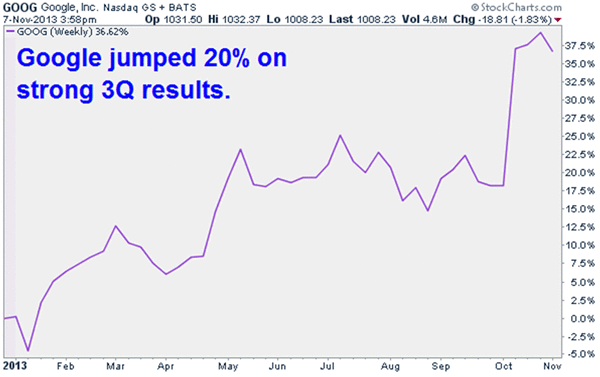Technology stocks are notorious for being vulnerable to upstart competition.
This is what Warren Buffett calls a moat: how a company insulates itself from smaller, faster and more agile companies.
But there is a global leader in technology that is breaking the rules.
Here’s what Buffett’s second-in-command Charles Munger had to say about it:
“This company has a huge new moat. In fact, I’ve never seen such a wide moat. Their moat is filled with sharks.”
This stock is only one of the 10 my colleague Dave Forest loves right now. In fact, wide moats, buybacks and dividends are what Dave looks for when picking hisTop 10 Stocks for 2014. One stock has raised its dividend 36 times since 2004, while another has boosted its dividend a whopping 183% since 2011. And that's just the beginning. To get more information -- including names and ticker symbols -- click here.
So, Dave loves companies with wide moats. That’s exactly why he and I are bullish on one of the largest and most successful technology companies in the world. In a field notorious for new competition, it continues to produce market-leading innovations to reinforce its competitive moat.
That has lifted shares to a new all-time high above $1,000. Take a look below.

Google, Inc. (Nasdaq: GOOG) is already one of the most valuable and powerful companies in the world. Since going public in the summer of 2004, shares are up more than 844%, giving the company an eye-popping market cap of $336 billion.
But instead of its huge success becoming a liability for growth, Google is using its market-leading position to reinforce its competitive moat and as a bridge to tap into high-growth markets.
Google already dominates the global search market, capturing 67% of the domestic search market in July 2013... and 90% in the U.K., France, Germany and Spain. Google is also the market leader in Canada, Latin America and most Asia/Pacific countries. That gives investor’s unparalleled exposure to long-term growth in online search and web traffic.
Google is also quietly the No. 1 player in mobile operating systems with its popular Android platform. Using an open source platform that can operate across multiple hardware devices has been a huge score for Google and another big miss for Apple, Inc. (Nasdaq: AAPL) locking itself into one ecosystem.
Google’s leading presence in search and mobile gives it the ability to either buy upstart competition or price them out of business with its size and scale.
Beyond search and mobile, Google is also making waves with some of the industry’s most innovative projects.
Google is positioning itself to cash in on the fast growing wearables market with Google Glass. Research firm Juniper Research projects that 70 million wearables will be sold in 2017, up from 15 million this year. Google Glass is a direct play on that high-growth market, where a company like Google has the ability to kick-start a new segment of consumer gadgets.
The company is also moving into the broadband market with Google Fiber, a custom-built, high-speed network that is currently being tested in Kansas City.
And Google owns YouTube, the world’s second largest search engine, a proprietary Web browser in Chrome, document-sharing programs with Google Docs and online payment systems with Google Wallet.
This is the most exclusive portfolio of technology assets in the industry. And it’s turned Google into a financial fortress, with a cash balance topping $56 billion and just $3 billion in long-term debt. That gives Google plenty of flexibility to invest in growth and acquire smaller competitors.
Google is on pace to grow earnings 7% this year. Earnings growth is expected to accelerate in 2014, with the consensus estimate calling for 20% earnings growth and average earnings growth of 17% in the next five years.
Risks to Consider: Google’s performance depends heavily on the success of search, which accounts for 75% of total revenue. Although Google has been working aggressively to diversify revenue, it is a direct play on the strength of the search market.
Action to Take –> Google has seen big gains in 2013, with shares up 41% on the year. But with earnings and estimates on the rise as well, the valuation picture still looks good. Google’s forward P/E (price-to-earnings) ratio of 28 times is directly in line with its peer average. And with earnings expected to grow 17% annually for the next five years, Google is a buy anywhere below $1,000.



